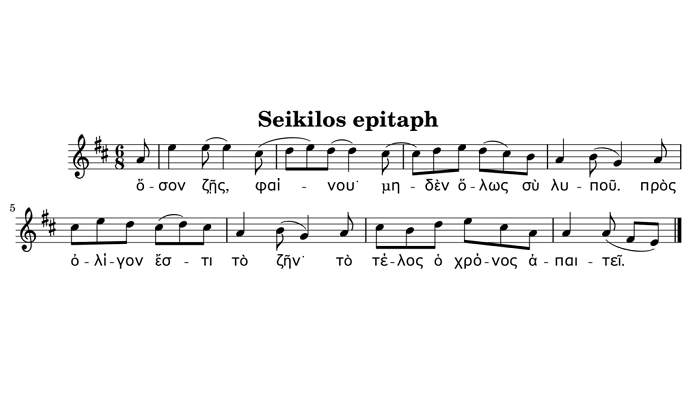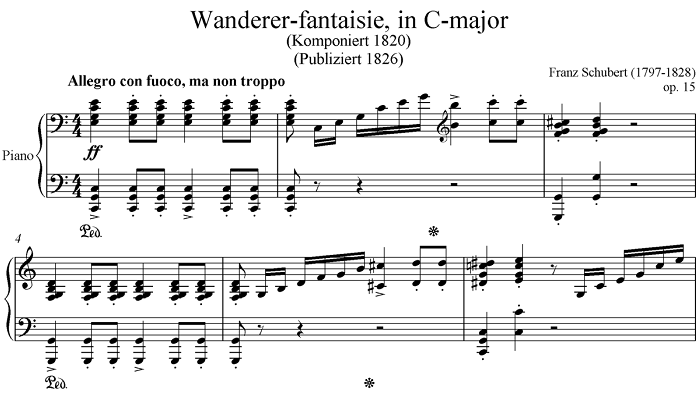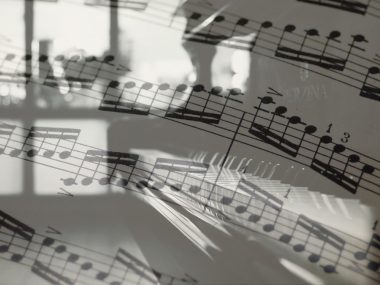Hurrian Hymn No. 6 is considered to be the world’s earliest melody. It was composed around the 14th century BC and was excavated in the 1950s from the ruins of the city of Ugarit in Syria.
So what is a melody? Why is it important in music composition? The answers to these questions can be found in this article, so keep on reading.
What is Melody in Music?
A melody is one of the most memorable parts of a musical composition, represented by a timely linear sequence of notes or sounds that the listeners identify as a single entity.
It’s a combination of pitch and rhythm to create a part of a song that you can easily identify.
Melodies can be vocal or instrumental and are crucial in all types and genres of music. When different notes are stacked on top of each other, a melody transforms into harmony.
A melody is a basic element of music, where the pitch and duration identify a note. A melodic line is the succession of notes that make up a melody, while extras such as slides might not be part of the main melody but are later added as embellishments.
The melody can be a vocal solo or a guitar riff. Even the simplest melodies are identifiable because they’re unique. It can also be recognized as the tune of the song, regardless of the music genre.
Melodies can be simple or complex when combined with other notes in a musical composition. Most composers use multiple melodies from several musical instruments to create their musical arrangements.
What are the Characteristics of a Melody?

A melody has several characteristics that help listeners identify and recognize it.
- Pitch is the actual audio vibration and is arranged as a series of notes. It refers to how high or low the note is.
- Duration is the time that each pitch will sound. It represents the interval between two pitches. Durations are divided into lengths as whole, half, or quarter notes.
- Range is either narrow, medium, or wide. It represents the distance between the lowest and highest tones of a melody, whether it’s vocal or instrumental.
The space between these two notes is large in a wide-range melody and small in a narrow-range melody.
- Shape is the direction of the melody. It can either go up, down or remain static, depending on how the notes are arranged.
- Phrase is a component of a melody. It refers to units that help us understand a larger melodic structure that makes it easier to identify, study, and recognize.
A phrase is made up of notes that make sense together, and several phrases will make up one melody. After phrases, there are pauses.
- Cadence is a resting place in musical composition where the melodies are composed.
- Countermelody is a secondary melody playing against the original melody, adding more texture to the musical composition.
A melody will be boring if it has the same shape, but the composer usually moves to higher or lower notes to create the shape or curve of music. This movement can happen slowly or quickly, depending on the musical composition and the music genre.
You can identify the shape or contour of the music by looking at the music sheet or by listening to the notes. This is called an arc-shaped melody.
Don Juan by Richard Strauss is a famous example of an ascending melody, while Joy to the World by George Frideric Handel is an example of a descending melody.
Arp Dinkelaker’s A Serial Serenade is an example of an undulating melody, where the notes move in both directions.
Plain Indians’ music is characterized by cascading melodies, where each phrase begins with a higher pitch than where the previous one ended and then descends.
Dmitri Shostakovich’s Romance is an example of an arc-shaped melody, where the melody rises and falls in the shape of a curve.
The interval between the rising and falling melodies is usually equal. This style is also very common in Navajo Indians’ music.
What is the Function of a Melody?

The melody is the song’s main focus and is what the composer uses to convey their emotions and messages to the audience. The shape of the melody in the composition is known as the melodic contour.
The melodic contour gives the melody its shape and personality as the notes keep on rising and falling in a way that can help you differentiate between two melodies once you start listening to either of them.
Notes can also be represented as stairs, right next to each other.
Notes that step from one note to another to create a conjunct, which refers to the slow motion of notes. While, when they leap from one note to another, they create a disjunct, which is the fast motion of the notes.
The conjunct and disjunct refer to how quickly the melodies go up and down. Music composers use both conjunct and disjunct motions to add character to the musical composition.
“Lean on Me” is one of the most famous pieces with a conjunct motion. The motion between notes is smooth. The melody can be referred to in the form of steps, as the interval between melodies is determined by either half or whole steps.
A disjunct motion is the opposite of the previous because the melody leaps and doesn’t move smoothly. “Somewhere Over The Rainbow” is a clear example of how the notes skip and leap. The changes are more notable.
In most cases, a music composer uses both conjunct and disjunct motions in a single composition to create contrast between different segments.
What are the Different Types of Melodies?

Melodies are either instrumental or vocal, depending on how they’re produced. Instrumental and vocal instruments are either used alone or combined to create musical compositions.
Since they represent a crucial part of your musical arrangement, they’re divided into three types.
Color Melodies
They sound pretty and catchy, and are easily recognizable. They’re usually made up of one or two notes and usually have a clear base pitch.
Color melodies are mainly combined with chords to make them more interesting, as the chords add emotions to the melodies. The melodies can be dreamy, happy, sad, strong, or hypnotic, depending on how the chords are arranged.
Color melodies are groove-based and are common in all genres, especially pop music.
Direction Melodies
These melodies go somewhere and use different notes. They don’t have a clear base pitch, and you don’t come to the same base pitch over and over again like a color melody.
These melodies are quite more challenging to sing and can be found mainly in Jazz and Soul music. Direction melodies are melodic.
Blend Melodies
These melodies combine color and direction. They’re common in most genres and represent a safe choice for music composers as they can be interesting and fun.
Blends shift their base pitch every 1 or 2 bars. These melodies are both groove-based and melodic.
How Does Sheet Music Show Melody?

A melody is shown on a music sheet by identifying the pitch and duration. The musical notation shows the pitch on a 5-line staff, and the duration is shown by the shape of the note.
Melodies can be short, known as motifs or riffs. Longer melodies can represent a longer line of an instrumental performance or chorus.
Notes are placed on the staff, which could be a line or space on the music sheet to tell us which note to play on the instrument and how long it should be played. Each note is made of three parts, the note head, the stem, and the flag.
Note Head
This is either filled and colored black or open and left white. The head is placed on the staff to determine which note or key to play. In some cases, the notes sit above or below the staff, on a line drawn and known as the ledger line.
Note Stem
This the line that extends from the head and can go either up or down. When it extends upward, the line extends on the right side of the head. When it extends downward, it’s drawn on the left side.
This doesn’t affect how the note is played but will make the note easier to read while you’re reading the music sheet. In general, notes at or above the B line point downwards, while those below the line point upward.
Note Flag

This is a mark drawn to the right of the note stem and shows the duration of the note. The more flags, the shorter the note will be.
The combination of the head, stem, and flag will tell us the note value. An open note is a whole note held for four beats, while one with a stem is half a tone and lasts two beats. A closed note with a stem is quarter a note and lasts one beat.
A dot can be added after the note to extend its duration by half the note’s value. Ties are used to join notes together, and in this case, both notes will be held as long as the combination of their values together.
While reading the music sheet, you’ll be able to identify major, minor, modal, and other unique scales that make different melodies.
Using sharp or flat semitones, a music composer is able to make an endless variety of melodies that add character to the music composition.
In order to read a melody in a music sheet, you need to understand key signatures. scales are named after their tonic, and you can start the scale on any note.
Sometimes, the sharps and flats are placed right before the meter to show that they need to be maintained throughout the music. In some cases, a natural symbol is placed to cancel or override the semitone.
How Did Melody Originate in Music?
Music is as ancient as the history of mankind, but there isn’t clear evidence of how the first melody was composed.
Nevertheless, some artifacts told us about the evolution of melody with surviving scripts that tell us about the oldest melodies composed.
Hurrian Hymn No. 6

The Hurrian Hymn No. 6 is the longest surviving melody, and although the tune was incomplete, it fits the definition of a musical melody.
This melody is one of 36 hymns found on clay fragments engraved sometime in the fourteenth century BC.
However, this song is the only one that survived in a complete form that allowed researchers and scholars to study it to understand the origin of melodies.
When they were discovered, scientists found that the clay tablets explained the musical intervals to play the notes, in addition to methods to fine-tune the Babylonian lyre or harp, which was most likely used to play the melody.
Just like most music created in ancient times, the hymn contains lyrics about offerings to Nikkal, the goddess of orchards and wife of the moon god. It combined both vocal and instrumental melodies.
The lyrics were written in a continuous spiral form, which is not common in Babylonian texts. This suggested that musicians probably used this specific method to document music notations and accompanied lyrics.
There are instructions for playing the instrumental notes under the lyrics, with interval names and note signs. There’s also a line of text that explains the purpose of this hymn and the name of its author.
On other clay tablets, the name of the music composer was registered, but the music composer of this hymn remains anonymous.
The text on the tablet was different from the original Ugarit dialect, suggesting that the pronunciation of some words might have been alerted to go better with the music.
Seikilos Epitaph

Although not the oldest melody, the longest surviving complete melody is a Greek piece known as Seikilos Epitaph.
This contained several vocal melodies and instructions for the instrumental melodies that were most probably played on the lyre.
Compared to the Hurrian Hymn No. 6, the Seikilos Epitaph is more complicated. The date of composing this melody is unknown, but researchers suggest that it was composed between the first and second century CE.
The song was engraved on a tombstone from the Hellenistic town, Tralles, in Turkey. The surviving artifact includes a complete musical notation, along with its lyrics.
The song is probably a dedication from a man to his wife, although some scientists also believed that it’s dedicated to the muse of music.
According to the definitions of western music, this is an ascending melody. It’s structured along a single octave, but the melody is made of disjunct notes.
There are unknown marks in the music sheet, marked by dots and called stigma. Although their exact meaning is unknown, some scholars believe that they refer to a kind of upbeat.
Melodies in Different Genres

Melodies were considered as key components of music throughout history, showing a slight but consistent evolution during the Medieval and Renaissance eras. However, the biggest evolution started to happen in the European Baroque era.
Later on, different genres added special elements to melodies to give the music its signature taste and feel.
Baroque Music Melodies
By the end of the Renaissance era, music composers wanted to incorporate elements of the Baroque era into their creations.
As the architecture style shifted from being classic to bizarre with heavy ornaments and embellishments, musicians followed the same technique while creating their new pieces.
The transitional period between the Renaissance and Baroque eras shows how ornamentation was added to vocal and instrumental melodies.
Musicians like Philippe de Monte added these elements to their church and secular music. As a famous madrigalist, he focused on creating prolific music and masses.
Composers also added a sense of drama to their vocal and instrumental music forms, with vibrant rhythms.
The Baroque era also marked the widespread use of the harpsichord, which tempted musicians to create unique dance pieces which were usually upbeat.

Giuseppe Domenico Scarlatti wrote special harpsichord music that was later considered as a foundation for Classical music.
Johann Sebastian Bach is one of the most famous Baroque composers. His music is characterized by having lots of notes and simple rhythms. Bach explored harmony and employed jazzy chords more than others.
Moreover, his music introduced the idea of melodic tone, where the melody is a concept by itself and can exist apart from any particular instrument.
He also introduced the idea of counterpoint, where two independent lines were composed, and each made musical sense by itself but would combine together seamlessly.
He also excelled at the fugue, which was a more challenging form of contrapuntal music. Bach’s fugues for the keyboard represent a landmark for western classical music.
Baroque melodies were characterized with the following.
- Having a single melodic idea that progresses throughout the composition, expressing one idea or mood.
- Music had too many ornaments and embellishments compared to Renaissance music.
- Melodies were balanced with chordal harmony.
- Compositions relied on instrumental melodies of strings and winds, in addition to the harpsichord with minimal percussion.
- Melodies would shift from loud to soft by adding or subtracting instruments.
Classical Music Melodies

Although the Classical music period is between the mid-18th century and early 19th century, the term is usually used to refer to some western music styles that are still used today.
Some scholars even consider periods as early as the 16th and 17th centuries to be part of the Classical music era.
Musicians of the Classical era managed to create a traditional form of music, which later set the foundation for different genres of western music.
By the end of the Baroque era, musicians as well other artists were heavily invested in the Rococo style, which relied heavily on ornaments. This opened doors to a new music style, known as the Style Galant.
One of the most famous names in this era is the name of Joseph Hayden, who is also known as the father of the symphony.
His work was the foundation for the modern sonata form, and his music is also known for its humor and surprise factor, especially in the Surprise Symphony.
Since most of his music was to please the audience, it was characterized by having upbeat melodies.
His music was composed during the period where Baroque music was starting to go out of fashion, so it was a period of experimentation, exploration, and uncertainty.
Throughout the years, his musical compositions gained more complexity and sophistication.
Wolfgang Amadeus Mozart started composing music that was different from the Style Galant by focusing on the emotional aspect of the music rather than the technical sophistication.

Thanks to him, the Classical piano concerto became a well-known musical form.
Mozart wrote lots of religious music, in addition to dancers, serenades, and other forms of light entertainment.
His music was characterized by relying on balanced and clear melodies. His String Quartet in C major, K. 465, is a clear example of the introduction of chromatic suspensions.
Ludwig van Beethoven’s music was divided into three periods, with the latest setting the foundation of music to be composed in the Romantic era.
During his life, Beethoven explored new directions and relied heavily on intensifying his personal expression.
Classical melodies were characterized with the following.
- Melodies were balanced and clear.
- Contradicting moods.
- Emphasis on emotions, elegance, and balance, as opposed to heavily embellished music of the Baroque era.
- Instrumental melodies relied on instruments like the piano.
- Homophonic textures with some use of contrapuntal melodies.
- The combination of vocal and instrumental melodies.
Romantic Music Melodies
Romantic music, just like other art forms of the Romantic era, was heavily influenced by nature, literature, poetry, and other forms of fine arts.
The whole movement was revolutionary compared to the Classical norms that prevailed for centuries.
Compared to previous composers of the Classical era, Romantics were independent.
They had more freedom to compose melodies that better expressed their emotions versus writing melodies to please the audience. However, some composers followed a different direction.

Franz Schubert was a prolific musician of the late Classical era and early Romantic era, with music compositions that relied heavily on pleasing melodies that lacked the drama that was to be found in other composers’ work.
Musicians like Pyotr Ilyich Tchaikovsky used motifs from traditional Russian Folk music and combined them with western melodies to create new musical compositions that were interesting and unique in nature.
On a technical level, modulating became a challenge for some composers of the Romantic era as they were introducing a new contrasting theme, which was not common in Folk music which served as an inspiration.
Sergei Rachmaninoff was influenced by his work, although his compositions showed more boldness.
His melodies showed more expressions that were unprecedented in Russian music. Most of his melodies were closely related to the chants of the Russian Orthodox Church.
Romantic melodies were characterized with the following.
- Melodies followed the freedom of form and design.
- Music was inspired and heavily affected by nature.
- Vocal melodies combined with chromatic harmonies.
- Melodies were affected by mystery, spookiness, and strangeness.
- Melodies relied heavily on contrasts between pitches.
- Big orchestras played music.
- Disconnection from traditional musical formulas.
Jazz Music Melodies

Although it originated in the African-American communities of New Orleans in the United States, Jazz music quickly spread as a popular form of music that characterized the roaring 20s.
Jazz melodies traveled throughout the world, borrowing influences from cultural, national, and regional music. Later on, these influences became so prominent that they created several subgenres like Cuban Jazz and Latin Jazz.
Jazz melodies were different from the forms of Classical and Romantic music because they were famous for improvisation and freedom of style. Church hymns and African heritage also influenced the music.
Jazz melodies were characterized with the following.
- Complex chords.
- Blue and swing notes.
- Melodies borrowed from traditional African music.
- Call and response vocal and instrumental melodies.
- Bent and innovative notes.
- Distinctive vocal melodies.
Rock and Roll
Rock’n’roll evolved in the USA during the 1950s and became quite popular during the 1960s as the music genre spread to the rest of the world.
It was influenced by Folk, Country, Jazz, and Gospel music, with distinctive characteristics that gave this genre its taste.
Forms of Rock’n’roll like Rockabilly and Doo-wop managed to incorporate vocal and instrumental melodies that would focus on emotions and issues that young people dealt with.
Rock and Roll melodies were characterized with the following.
- Call and response melodies, usually between a vocal and a guitar solo.
- Male and backing vocals.
- Instrumental melodies that relied on the electric guitar, double bass, and drums.
- Energetic delivery of both vocal and instrumental melodies.
- Melodies are composed using the 12-bar chord structure.
Disco

Disco emerged in the 1970s, setting up the foundation for other music genres like Post Punk, Hip Hop, and Acid Jazz.
It also influenced the overall culture, including art and fashion as a modern way of expression. With roots in Soul music, Disco relied heavily on strong beats.
Disco melodies were characterized with the following.
- Melodies with a fast tempo.
- A time signature of 4/4.
- Guitar-driven melodies with high-energy instrumental melodies and syncopated bass lines.
- Vocal melodies with reverb.
- Rich orchestral arrangements.







